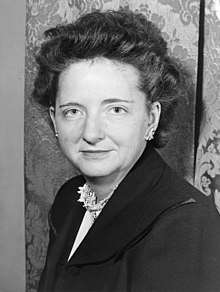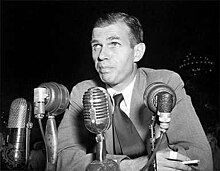John Chabot Smith
John Chabot Smith (1915-2002) was an American journalist and author, best known for Alger Hiss: The True Story, an account sympathetic to Hiss.[1][2][3]
Background[]
John Chabot Smith was born on September 1, 1915, in Croydon, UK. He attended the Loomis Institute. He majored in history at Princeton University. He did graduate studies at Cambridge University.[1]
Career[]

Smith began his career as a journalist with the Washington Post. He joined the New York Herald Tribune as White House correspondent.[1][2][3]
Smith covered World War II overseas for the Herald-Trib.[1][2][3] called him a "pro-Tito correspondent."[4]
Smith covered Elizabeth Bentley.[5]
Smith covered the Hiss Case for the Herald Trib and later wrote a book about it, and about Hiss’s life in general.[3] Three other journalists who covered the case also published books about it: Bert Andrews of Hearst, Ralph de Toledano of Newsweek, and Alistair Cooke of the Manchester Guardian.
Hiss appeared with Smith at a press conference to promote the book, held at the Overseas Press Club.[6]
Personal life and death[]
In 1940, Smith married Betty McCarthy; they had two children. She predeceased him.[1][2]
Smith died age 86 on May 16, 2002, in Brooklyn, New York.[1][2]
Works[]

Of his book on Alger Hiss, Kirkus noted: "Don't expect bombshells. The hard evidence is slow in coming and can be bewilderingly technical when it come."[3] According to Allen Weinstein (whose book Perjury: The Hiss–Chambers Case, published in 1978, had different findings), "Smith adopted elements from a least six previous theories.[7] The Western Journal of Speech Communications assessed the book as "thoroughly sympathetic" Hiss.[8]
Books include[]
- Alger Hiss: The True Story (1976)[9]
- The Children of Master O'Rourke: An Irish Family Sage (1977)[10]
Articles include[]
- ”Woman Informer Against Reds Is Called by Thomas Committee" New York Herald Tribune (29 July 1948)[5]
- "On Alger Hiss" New York Review of Books (25 November 1976)[11]
- "The Debate of the Century" Harper's Magazine (June 1978)[12]
See also[]
References[]
- ^ Jump up to: a b c d e f "Memorial: John Chabot Smith '36". Princeton Alumni Weekly. 25 November 1976. Retrieved 17 October 2018.
- ^ Jump up to: a b c d e "Smith, John Chabot". New York Times. 18 May 2002. Retrieved 17 October 2018.
- ^ Jump up to: a b c d e "Alger Hiss: The True Story". Kirkus. 22 May 1976. Retrieved 17 October 2018.
- ^ (1945). Trouble zone: brewing point of World War III?. Ziff-Davis. p. 102. Retrieved 17 October 2018.
- ^ Jump up to: a b Smith, John Chabot (29 July 1948). "Woman Informer Against Reds Is Called by Thomas Committee". New York Herald Tribune.
- ^ White, G. Edward (2005). Alger Hiss's Looking-glass Wars: The Covert Life of a Soviet Spy. Oxford University Press. p. xiv. ISBN 9780195182552. Retrieved 17 October 2018.
- ^ Weinstein, Allen (1978). Perjury: The Hiss Chambers Case. Knopf. p. 558. ISBN 9780394495460. Retrieved 17 October 2018.
- ^ Western Journal of Speech Communications. Taylor & Francis. 1984. p. 98. Retrieved 17 October 2018.
- ^ Smith, John Chabot (1976). Alger Hiss Chambers Case. Holt, Rinehart and Winston. ISBN 9780030137761. Retrieved 17 October 2018.
- ^ Smith, John Chabot (1 September 1977). The children of Master O'Rourke: an Irish family saga. Holt, Rinehart and Winston. ISBN 9780394495460. Retrieved 17 October 2018.
- ^ Smith, John Chabot (25 November 1976). "On Alger Hiss". New York Review of Books. Retrieved 17 October 2018.
- ^ Smith, John Chabot (June 1978). "The Debate of the Century". Harper's Magazine. Retrieved 17 October 2018.
- 1915 births
- 2002 deaths
- American male journalists
- New York Herald Tribune people
- 20th-century American journalists
- 21st-century American journalists
